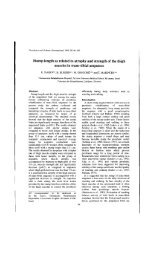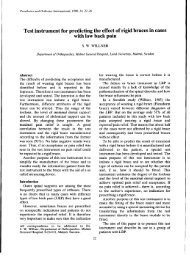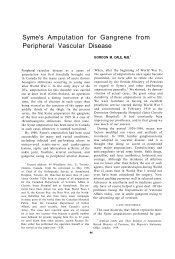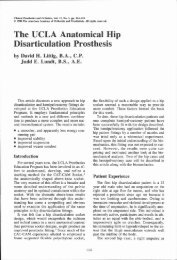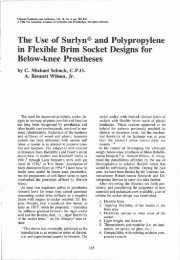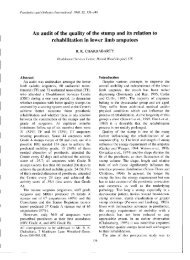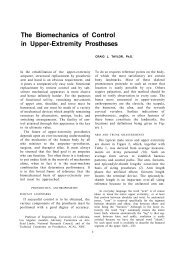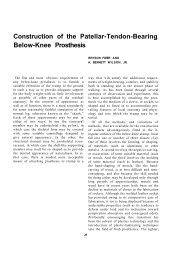Pro-Corn - O&P Library
Pro-Corn - O&P Library
Pro-Corn - O&P Library
You also want an ePaper? Increase the reach of your titles
YUMPU automatically turns print PDFs into web optimized ePapers that Google loves.
Figure 8. Percent pressure reduction at the heel walking in cast shoe-2 (CS-2), short<br />
leg walker (SLW) and patellar tendon bearing walker (PTBW) compared to walking<br />
in cast shoe-1.<br />
ylene, non-custom molded patellar tendon cuff.<br />
Since no treatment difference was seen between<br />
these devices, the PTBW cuff design must not<br />
have been effective. However, in follow-up,<br />
single subject trials, we were not able to change<br />
walking pressures by redesigning the PTBW<br />
cuff using polyethylene or plaster custom<br />
molded PTB cuffs. An alternative conclusion is<br />
that the SLW design alone optimally reduced<br />
plantar pressure by the fixed ankle joint and<br />
uprights snugly supporting the lower leg and<br />
calf.<br />
In this study, orthopedic walkers were<br />
equally effective in reducing pressure at all sites<br />
tested on the foot. In previous studies, casts<br />
were shown to reduce pressure more effectively<br />
in the forefoot than the heel, and PTB orthotics<br />
reduced pressure more effectively in the heel<br />
than the forefoot. 2,11,15<br />
Based on the results of this study, othopedic<br />
walkers may be effective devices in the reduction<br />
of plantar foot pressure in patients with<br />
neuropathic conditions of the foot. There is no<br />
evidence to show that the PTBW will be more<br />
effective than the SLW. Further study utilizing<br />
a patient population is recommended.<br />
Conclusions<br />
Within the scope of this study, it is possible<br />
to conclude the following: (1) SLW and PTBW<br />
orthopaedic walkers are effective in reducing<br />
pressure at the first MTH, third MTH, fifth<br />
MTH and heel in normal subjects during<br />
walking, and (2) there is no difference in pressure<br />
distribution between the SLW and PTBW<br />
during walking.<br />
References<br />
Anderson, J.G., "Treatment and Prevention of Plantar<br />
1<br />
Ulcers," Leprosy Review, 35, 1964, pp. 251-258.<br />
2<br />
Birke, J.A. and D.S. Sims, "Walking Casts: Effect on<br />
Plantar Foot Pressures," Journal of Rehabilitation Research<br />
andDevelopement, 22:3, July, 1985, pp. 18-22.<br />
Brand, P.W., "The Insensitive Foot," Editor M.H.<br />
3<br />
Jahss, Disorders of the Foot, Vol. II, W.B. Saunders,<br />
1982, p. 1266.<br />
Cterctecko, G.C., M. Dhanendran, W.S. Hutton, and<br />
4<br />
L.P. LeQuesne, "Vertical Forces Acting on the Foot of<br />
Diabetic Patients with Neuropathic Ulceration," British<br />
Journal of Surgery, 68, 1981, pp. 609-614.<br />
5<br />
Coleman, W.S., P.W. Brand, and J.A. Birke, "The<br />
Total Contact Cast: A Therapy for Plantar Ulceration of the<br />
Insensitive Foot," Journal of the American Pediatric Medical<br />
Association, 74:11, November, 1984, pp. 548-552.



